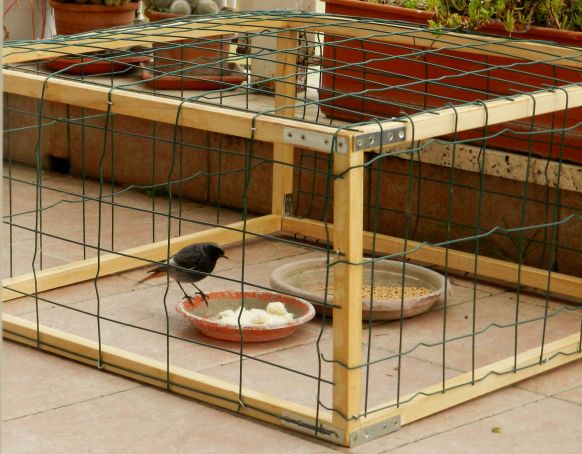A variety of birds can be watched from Roman balconies and gardens.
Apart from their cheerful, colourful appearance and songs, birds are important animals. They help control insect pests and, in fact, save many important food crops from destruction. Seagulls and crows (plenty of them in Rome) annoy many people who would be happy to see them go but, if they went, the city would suffer.
These birds raise families each year, thousands of them, and feed their growing chicks on any edible food remains they find in the streets and rubbish bins. During the breeding season, they move tons of waste from the city that would otherwise cause health problems and smell, as well as attracting rats and other vermin.
Pigeons
Many people classify gulls and crows and, especially, pigeons, as vermin. But crows and gulls, both present in Rome thanks to humans and their activities, are helpful members of society. Pigeons are accused of carrying diseases. In fact, they carry less disease than dogs and cats and even less than we humans do. A little research on the internet should convince anyone interested that they are no more harmful to our health than our domestic pets.
Keen bird-watchers are out every day observing, recording and photographing birds. However as one grows older and busier with family life the opportunities for kitting up with backpack, boots, binoculars and books, and heading for the countryside, mountains or sea become fewer and fewer. Never mind, don’t give up: Rome is full of birds and from our balconies and windows we can record many different species, including some rather special ones.
Hoopoes used to pass through the centre of Rome when they were nesting in Villa Celimontana each spring, several decades ago. Cranes, tired after their long migration from Africa, are sometimes seen over Rome as they look hopefully for somewhere to rest and feed, which is usually on the banks of the Tiber. Cormorants and ducks also are often seen flying towards the river. Woodpeckers can be spotted searching in city gardens for ants.
Birdseed
December to March are the best months for bird-watching from home, as food is scarce for birds and a supply of it will always attract them. This provides a chance to see them up close, which makes identification much easier. A small garden, a terrace or balcony, even a windowsill loaded with suitable food, will very quickly bring the birds to visit. Birdseed – any pet shop has it – will attract finches, with stubby, conical bills, such as sparrows and greenfinches.
Greenfinches love birdseed and will try to drive other seed-eaters away. Fascinating to watch. They are Rome residents and their trilling song can be heard in spring and summer when they are nesting in the trees along the roads.
The black redstart, a regular winter visitor from the north, loves grated cheese. The female has much duller plumage, which is normal for most birds since it makes her less noticeable when sitting on the nest
Winter
Feeding is most important during the winter to provide the energy birds need so much. Simple bird seed, husked sunflower seed, sultanas or currants (previously soaked in water), peanut powder mixed with suet or any hard-setting fat is a favourite with tits, once commonly known as titmice, and other insectivores. A can of dog or cat food, cooled in the fridge and then cut up into lumps will delight the crows – one can even, by making crow-like noises as the food is put out, train them to come and eat when called!
Robins, blackbirds and thrushes will be attracted by meal worms (actually beetle larvae) which are obtainable from some pet shops. Various containers for bird food are available from pet shops and online suppliers such as the Lega Italiana Protezione Uccelli (LIPU), the Italian organisation which strives to protect wildlife with a particular focus on wild birds and their habitats.
Crows and gulls
These crows are a sub-species of the carrion crow, which is entirely black. Carrion crows mainly inhabit the more central areas of Europe whereas hooded crows are commonly found in the northern and southern areas. They are great scavengers and sworn enemies of the yellow-legged gulls, which have become very common in Rome since first nesting in the city in 1971.
Commercial fishing has led to a colossal boom in the population of gulls, since the fishing boats dump offal into the sea, where it is gobbled up by gulls and other sea birds. The result is that coastal nesting sites have been exhausted, so the gulls have slowly moved inland and are now very common in most big cities as roofs and sills have proved to be perfect nest sites.
Parakeets
Gulls are carnivores and prefer meat of any kind, cooked or raw. They will attack, kill and eat pigeons and the parakeets which have colonised the city in recent decades. Three species of parakeet have been recorded: ring necked (very common), monk (less common) and eastern rosella (rare), not native to Rome, but “escapees” from captivity.
Pigeons, pretty as they are, can be a nuisance when one is feeding birds, since they come down in flocks and gobble up everything in no time at all.
Feeding cages
A feeding cage keeps pigeons out but allows smaller birds to enter and feed safely. Any carpenter could construct one given the plan. A simple wooden framework (65 x 65 x 30cm) covered in wire netting with spaces too small for pigeons to enter.
The feeding cage can, of course, be any size you wish, even tall enough for humans to walk into. If you only have a balcony or small terrace, simply adjust the measurements to suit the space available. Try to place the cage so that you have a good, clear view of it from the window so that it can be watched and/or photographed from inside the house without disturbing the birds.

When watching a bird, try to note features which help you distinguish between it and others which might, at first glance, seem similar. The colour and shape of head, wings, beaks and legs are all helpful when you come to try to identify a bird from a book. Photographs are clearly very helpful, but for these you will need a decent camera, preferably with a zoom lens to bring the image closer.
Feeding garden birds during the cold months when insects and plants are usually dormant is a good way to begin bird watching. With the spring, when insects and plants are again active and available, your garden birds will be active with nesting and food gathering. There will still be plenty of bird-watching available if, by then, you have been “hooked”.
Springtime
By April, migrant birds which have spent the winter in warmer climes will be returning to nest, given that the days here are longer than in Africa or other southern regions which gives birds here more time to forage for food for their nestlings. Flying overhead there will be swifts and swallows, the former screaming in the sky, the latter swooping near the ground as it hunts flying insects.
House martins, with white rumps, build their nests on buildings in the shelter of the eaves. Overhead there is a chance of seeing kestrels and peregrine falcons. Fans of warblers often call them “little brown jobs”, since so many of them are the same size and have plumages which are very similar. Identification usually needs a well illustrated bird book and this will became an essential tool.
By Gerry Firth
Suggested books
Kingfisher Field Guide to the birds of Britain and Europe by John Gooders.
Collins Pocket Guide, Birds of Britain and Europe by Heine, Fitter and Parslow.
Bird feeding
Lega Italiana Protezione Uccelli (LIPU), sells bird feeders for hanging and other equipment, see website.

















